Itron BCR900 AMR transceiver device for endpoint installation User Manual User s Guide
Itron, Inc. AMR transceiver device for endpoint installation User s Guide
Itron >
Contents
- 1. BCR900 - Users Manual
- 2. Users Manual
BCR900 - Users Manual
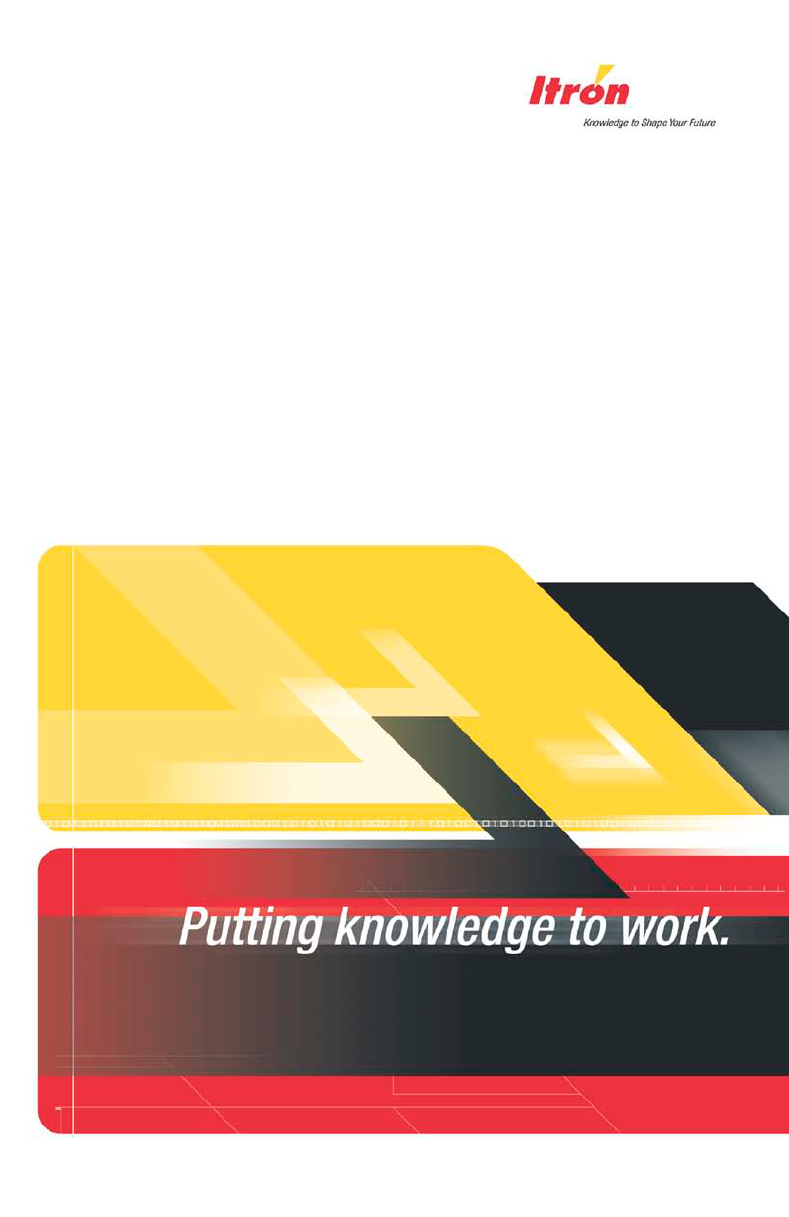
900 MHz Belt-Clip Radio
User’s Guide
900 MHz Belt-Clip Radio
Identification
900MHz Belt Clip Radio User’s Guide
12/16/2009 TDC-0889-000
Copyright
© 2009 Itron, Inc. All rights reserved.
Confidentiality Notice
The information contained herein is proprietary and confidential and is being provided subject to the condition that (i) it be
held in confidence except to the extent required otherwise by law and (ii) it will be used only for the purposes described
herein. Any third party that is given access to this information shall be similarly bound in writing.
Trademark Notice
Itron is a registered trademark of Itron, Inc.
All other product names and logos in this documentation are used for identification purposes only and may be trademarks or
registered trademarks of their respective companies.
Suggestions
If you have comments or suggestions on how we may improve this documentation, send them to
TechnicalCommunicationsManager@itron.com
If you have questions or comments about the software or hardware product, contact Itron Technical Support:
Contact
• Internet: www.itron.com
• E-mail: support@itron.com
• Phone: 1 800 635 8725
Patent Notice
US and foreign patents pending
Manufacturer: Itron, Inc.
Trade name: 900MHz Belt Clip Radio
Model number: 900 BCR Radio
Compliance Statement
This device complies with Part 15 of the FCC Rules. Operation is subject to the following two conditions:
(1) This device may not cause harmful interference, and
(2) This device must accept any interference received, including interference that may cuse undesired operation.
Class B Part 15 Compliance Statement
This equipment has been tested and found to comply with the limits for a Class B digital device, pursuant to part 15 of the
FCC Rules. These limits are designed to provide reasonable protection against harmful interference in a residential
installation. This equipment generates, uses, and can radiate radio frequency energy and, if not installed and used in
accordance with the instructions, may cause harmful interference to radio communications. However, there is no guarantee
that interference will not occur in a particular installation.
If this equipment does cause harmful interference to radio or television reception, which can be determined by turning the
equipment off and on, the user is encouraged to try to correct the interference by one or more of the following measures:
• Reorient or relocate the receiving antenna.
• Increase the separation between the equipment and receiver.
• Connect the equipment into an outlet on a circuit different from that to which the receiver is connected.
• Consult the dealer or an experienced radio or TV technician for help.
Industry Canada
This equipment complies with policies RSS-210 and RSS-GEN of the Industry Canada rules. Operation is subject to the
following two conditions:
• This device may not cause interference, and
• This device must accept any interference, including interference that may cause undesired operation of the device.
Note Modifications to the device or its antenna not expressly approved by the party responsible for compliance could void
the user’s authority to operate the device.
Transportation Classification
The Federal Aviation Administration prohibits operating transmitters and receivers on all commercial aircraft. When
powered, 900MHz Belt Clip Radios are considered operating transmitters and receivers and cannot be shipped by air. All
product returns must be shipped by ground transportation.

900 MHz Belt-Clip Radio User’s Guide iii
Proprietary and Confidential
Contents
Chapter 1 Introduction .............................................................................................. 1
Related Documents .................................................................................................. 1
Documentation Conventions .................................................................................... 1
Chapter 2 900MHz Belt Clip Radio Basics ................................................................ 3
Unpacking Your 900MHz Belt Clip Radio ................................................................. 3
Turning the 900MHz Belt Clip Radio On and Off ...................................................... 7
Chapter 3 900MHz Belt Clip Radio Features ............................................................ 9
LED Status Indicators ............................................................................................. 10
POWER LED ..................................................................................................... 10
COMM ............................................................................................................... 11
LINK .................................................................................................................. 11
USB Communication Port ....................................................................................... 12
Chapter 4 Mounting the 900MHz Belt Clip Radio ................................................... 13
Chapter 5 Maintaining Your 900MHz Belt Clip Radio ............................................ 15
Battery Overview .................................................................................................... 16
Replacing the Charging Cradle’s Contact Pins ...................................................... 19
Storing Your 900MHz Belt Clip Radio .................................................................... 19
Daily Operation ....................................................................................................... 20
Chapter 6 Safety ....................................................................................................... 23
AC Power Adapter .................................................................................................. 23
Chapter 7 Troubleshooting ...................................................................................... 25
Optimizing Bluetooth Performance ......................................................................... 26
Appendix A 900MHz Belt Clip Radio Capabilities and Limitations ..................... 29

Contents
iv 900 MHz Belt-Clip Radio User’s Guide
Proprietary and Confidential

900 MHz Belt-Clip Radio User’s Guide 1
Proprietary and Confidential
This document details the features and functions of the 900MHz Belt
Clip Radio (BCR) and provides information relating to its use and
maintenance.
Related Documents
The 900MHz Belt Clip Radio is designed for use with handheld and
laptop computers running Itron mobile data collection software
applications. For detailed information about these applications, see
the following documents:
• Endpoint-Link Pro Field Service Representative's Guide
(TDC-0735-xxx)
• Endpoint-Link Endpoint Programming Guide (TDC-0744-xxx)
• Endpoint-Link Installation Guide (TDC-0758-xxx)
• Service-Link Field Service Representative’s Guide
(TDC-0433-xxx)
Documentation Conventions
This guide uses the following documentation conventions:
Convention
Example
Key presses appear in
boldface. Press Enter when complete.
Menu paths appear in
boldface.
From the Start menu, choose
File > Save As.
(This example instructs the user
to choose File from the Start
menu; then choose Save As
from the File menu.)
Hypertext links appear in
blue text. See Copyright for identification
information.
Warning This type of note is used to warn of
potential physical harm to the user or hardware. It is
critical that you pay strict attention to Warning notes,
read the information carefully, and heed the advice
and/or instructions.
C
HAPTER
1
Introduction

Introduction
2 900 MHz Belt-Clip Radio User’s Guide
Proprietary and Confidential
Tip This type of note provides the user with extra
hints/tips to make a task easier to perform or a
concept easier to understand.
Caution This type of note advises users that failure
to take or avoid a specified action could result in a
loss of data.
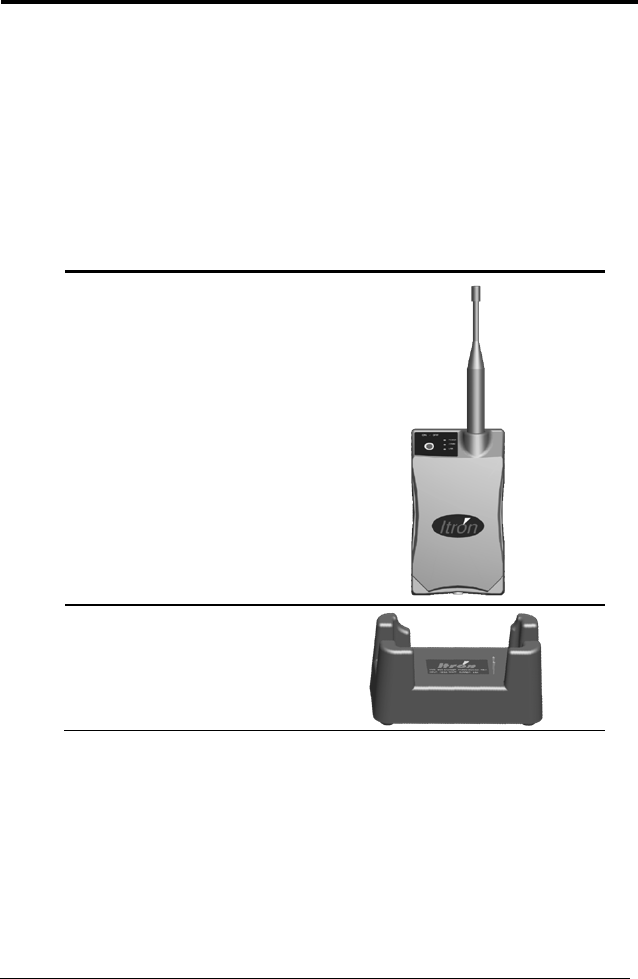
900 MHz Belt-Clip Radio User’s Guide 3
Proprietary and Confidential
The 900MHz Belt Clip Radio is a lightweight, compact device
designed for use with Itron mobile data collection software running
on FC200 and FC300 series handhelds and laptop computers. It is
used for reading, programming, and maintenance of Itron endpoints.
Because of its size and mounting options, the 900MHz BCR is easy
and comfortable to use.
Unpacking Your 900MHz Belt Clip Radio
The 900MHz BCR comes with the following items:
900 MHz Belt Clip Radio
Charging cradle
C
HAPTER
2
900MHz Belt Clip Radio Basics
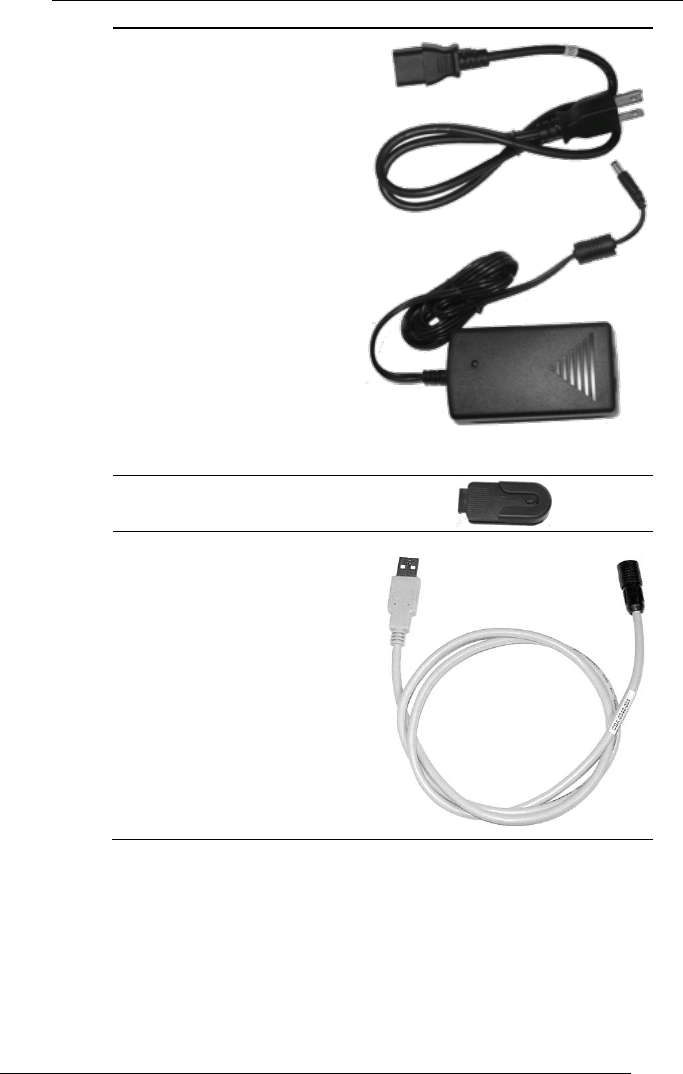
900MHz Belt Clip Radio Basics
4 900 MHz Belt-Clip Radio User’s Guide
Proprietary and Confidential
AC power adapter
Belt clip
Communication cable
When you unpack your BCR, make sure you have all of the
components listed here. If any are missing, contact Itron Support
Services immediately.
Charge the BCR’s battery to 100 percent capacity (this takes about
three and half hours) before using it. This helps insure the accuracy
of the BCR’s power gauge calculations. Frequent incomplete charges
lead to progressively larger errors that only a full charge can rectify.
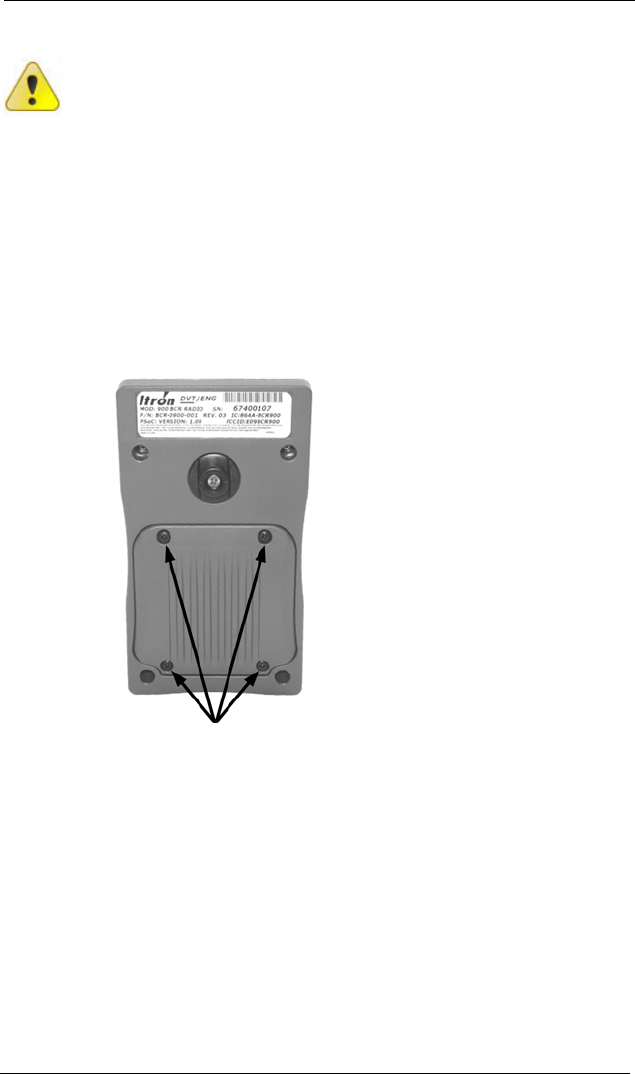
900MHz Belt Clip Radio Basics
900 MHz Belt-Clip Radio User’s Guide 5
Proprietary and Confidential
Caution Use only Itron-approved and -supplied
antennas with the 900MHz Belt Clip Radio. This
device has been designed to operate with an antenna
having a maximum gain of 2.1 dB. Antennas having a
gain greater than 2.1 dB are strictly prohibited for use
with this device. The required antenna impedance is
50 ohms.
Use only Itron-approved accessories with this device.
To install the battery
1. Unscrew the four screws that secure the battery compartment
cover to the back of the 900MHz Belt Clip Radio.
Remove the cover.
2. Four wires protrude from the top of the battery and end in a
small connector.
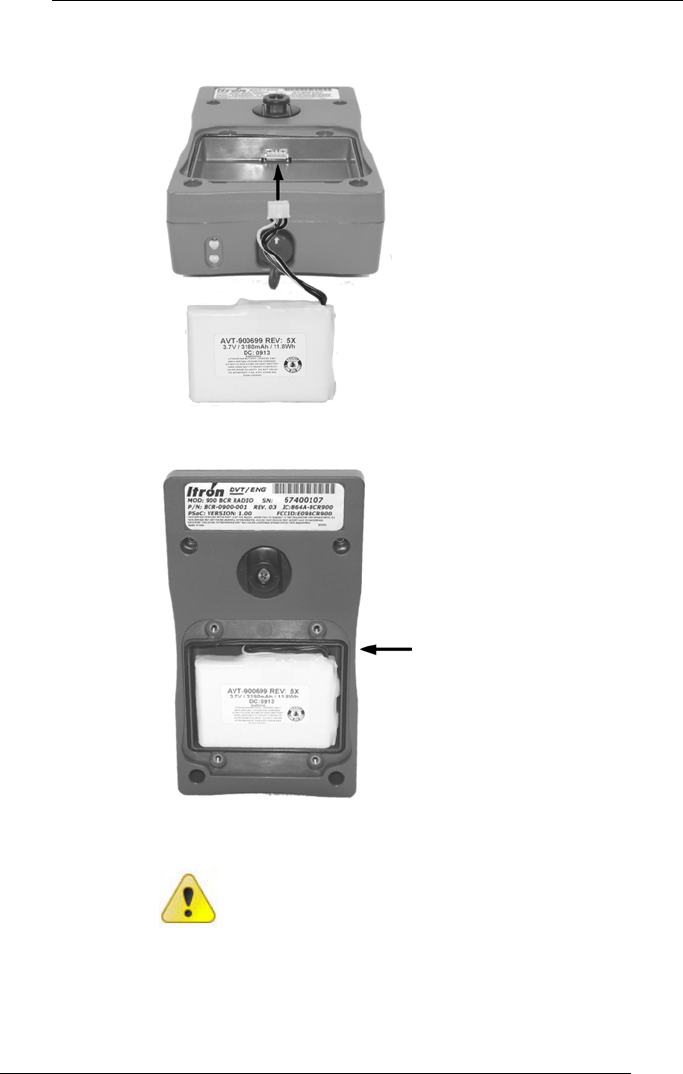
900MHz Belt Clip Radio Basics
6 900 MHz Belt-Clip Radio User’s Guide
Proprietary and Confidential
Plug the connector into the socket in the top of the battery
compartment.
3. Insert the battery into the compartment, carefully tucking the
wires into the space above the battery.
4. Replace the compartment cover and fasten it in place with the
four screws you removed in step 1.
Caution Be careful not to pinch the battery wires when
replacing the cover

900MHz Belt Clip Radio Basics
900 MHz Belt-Clip Radio User’s Guide 7
Proprietary and Confidential
Turning the 900MHz Belt Clip Radio On and Off
Turn on your 900MHz BCR as soon as you have unpacked and
charged it.
To conserve battery power, turn the radio off whenever you are not
using it.
To turn the radio on
• Press the ON/OFF button (see 900MHz Belt Clip Radio
Features on page 9).
The POWER LED shines green for two seconds to indicate the
power is on, and then it flashes to indicate the battery’s power
level (see Conserving the BCR’s Battery). After that, all three
LEDs (POWER, COMM, and LINK) flash in sequence,
indicating the system is ready for use.
To turn the radio off
• Press and hold down the ON/OFF button (see 900MHz Belt
Clip Radio Features on page 9) for three seconds.
The POWER LED shines red for five seconds to indicate the
radio is turning off.

900MHz Belt Clip Radio Basics
8 900 MHz Belt-Clip Radio User’s Guide
Proprietary and Confidential
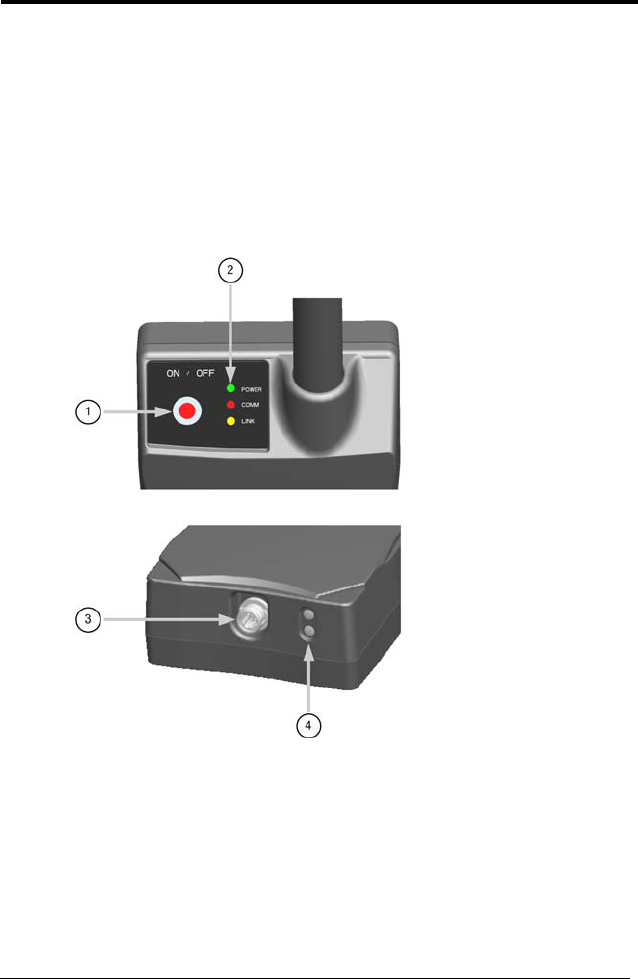
900 MHz Belt-Clip Radio User’s Guide 9
Proprietary and Confidential
The 900MHz BCR unit comes equipped with:
• An ON/OFF button (1) (see Turning the 900MHz Belt Clip
Radio On and Off on page 7)
• Three LED status indicators (2) on top of the unit
• A dual-function USB communication port (3) on the bottom
Also shown here are the two contacts (4) on the bottom of the BCR
through which the radio’s battery is charged when the BCR is in its
cradle.
C
HAPTER
3
900MHz Belt Clip Radio Features
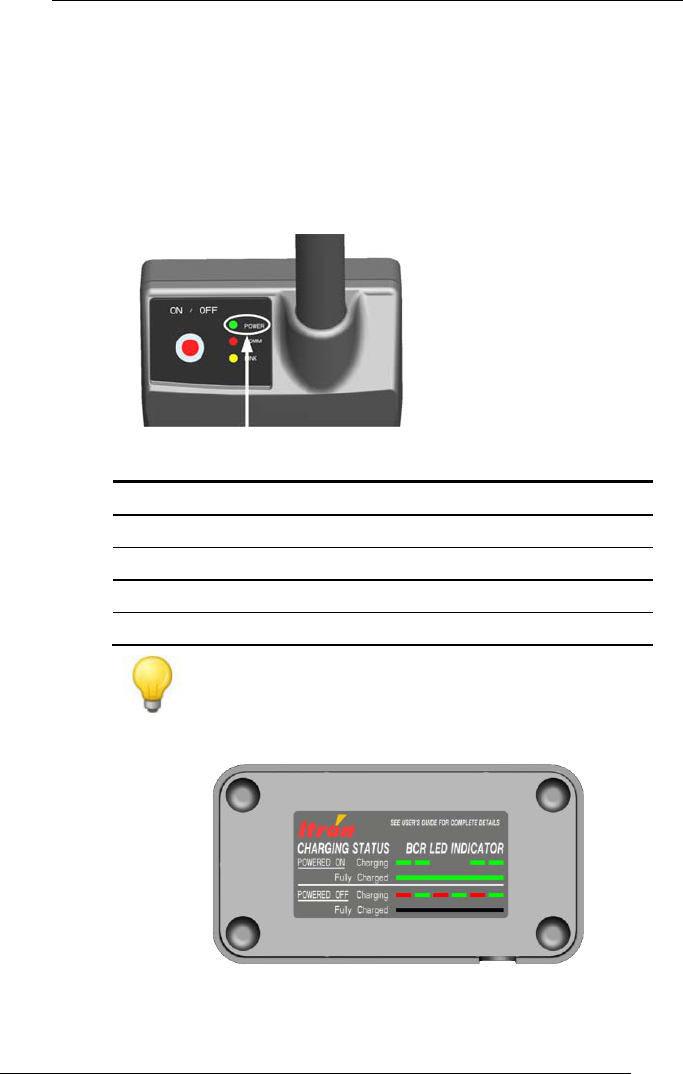
900MHz Belt Clip Radio Features
10 900 MHz Belt-Clip Radio User’s Guide
Proprietary and Confidential
LED Status Indicators
Three LED status indicators are located on the top of the radio,
labeled POWER, COMM, and LINK.
POWER LED
The POWER LED indicates the power status of the BCR’s battery
pack.
Power status
LED indicator
On/charging Double-flashes green every two seconds
On/fully charged Shines steady green
Off/charging Flashes red and green alternately
Off/fully charged No light
Low battery Flashes red every two seconds
Tip A charging status label is affixed to the bottom of
the BCR’s charging cradle to help you remember the
POWER LED indicators and the corresponding power
statuses.
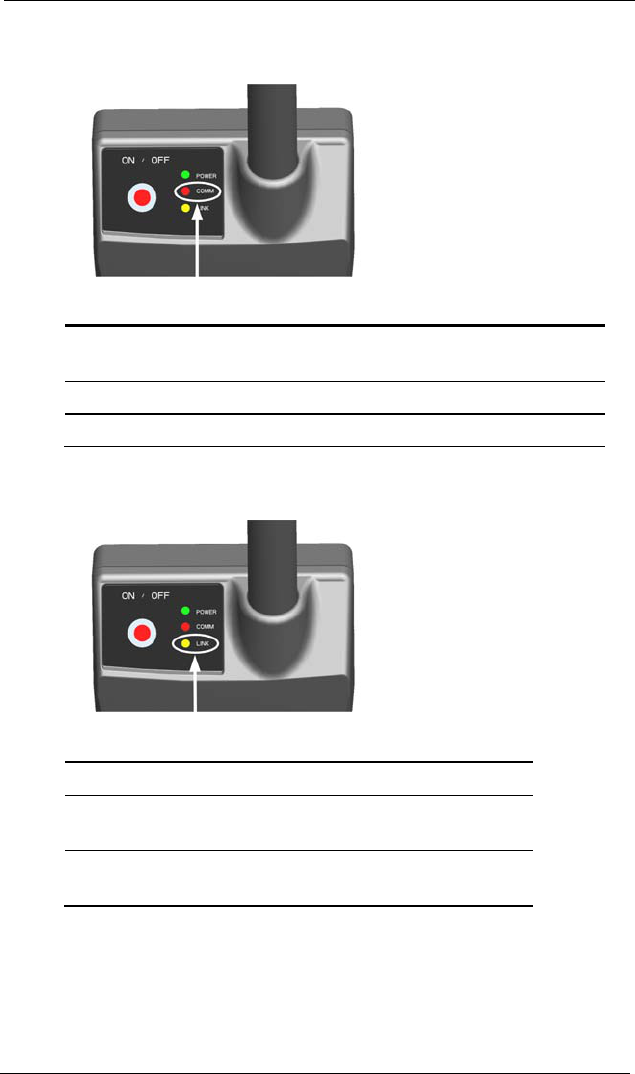
900MHz Belt Clip Radio Features
900 MHz Belt-Clip Radio User’s Guide 11
Proprietary and Confidential
COMM
The COMM LED indicates the radio’s Bluetooth connectivity status.
Bluetooth status
LED indicator
On and waiting to
connect Double-flashes blue every two seconds
On and connected Single-flashes blue every two seconds
USB Connection Flashes red every two seconds
LINK
The LINK LED indicates radio activity.
Radio activity
LED status indicator
Radio off Unlit
Radio enabled, no
actvity Unlit
Radio activity
indicated Flashing yellow light
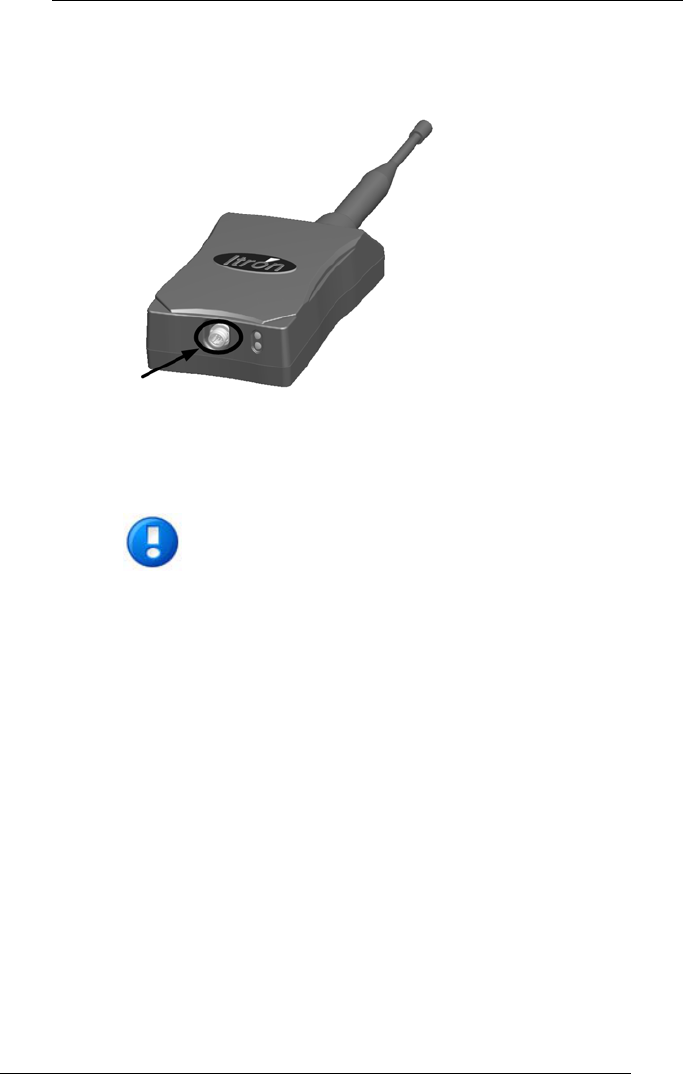
900MHz Belt Clip Radio Features
12 900 MHz Belt-Clip Radio User’s Guide
Proprietary and Confidential
USB Communication Port
The 900 MHz Belt Clip Radio has one dual-function communication
port on the bottom of the device.
The port provides the radio with a USB cable connection that enables
it to receive both USB communications and power from a host PC.
In addition, the radio is equipped with an internal port for wireless
Bluetooth communications.
Note When you connect the BCR to a PC, the computer’s
Windows operating system may prompt you to install an
updated driver for the device. If so, download the latest
FTDI driver from the web site of Future Technology
Devices International Ltd. (http://ftdichip.com). From the
site’s available D2XX direct (not virtual) drivers, select
the one appropriate for your operating system (version
2.06.00 or later). Download the installation .zip file to
your computer and, if needed, the corresponding
installation guide.
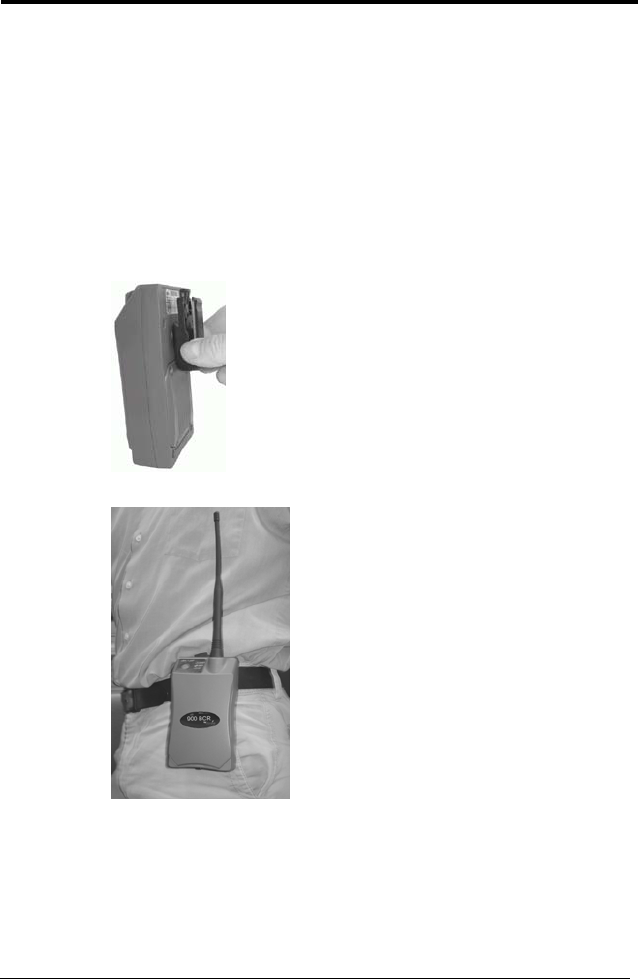
900 MHz Belt-Clip Radio User’s Guide 13
Proprietary and Confidential
The 900MHz BCR’s ergonomically designed belt clip provides a
convenient, hands-free way to carry the BCR while installing,
reading, and maintaining meters and endpoints. It lets you wear the
radio comfortably while walking or driving. As a safety feature, the
clip is designed to break away if the radio snags or becomes caught,
releasing the wearer and reducing the likelihood of injury.
To attach and use the belt clip
1. Slide the belt clip onto the round knob on the back of the BCR
until it clicks into place.
2. Clip the BCR to your belt.
The clip is designed to keep the BCR securely attached while
allowing the radio to swivel to accommodate your movements.
C
HAPTER
4
Mounting the 900MHz Belt Clip Radio

Mounting the 900MHz Belt Clip Radio
14 900 MHz Belt-Clip Radio User’s Guide
Proprietary and Confidential
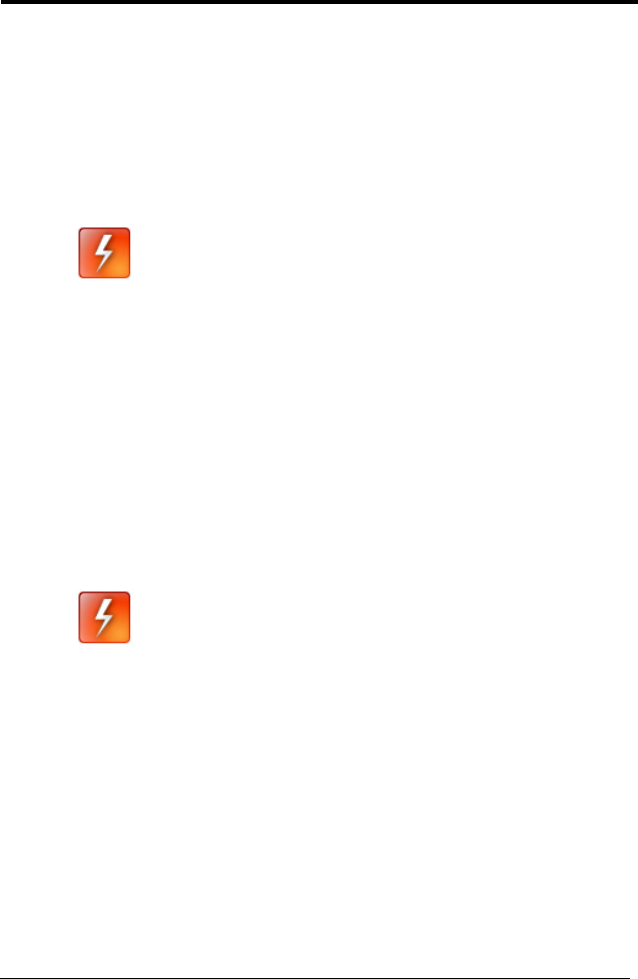
900 MHz Belt-Clip Radio User’s Guide 15
Proprietary and Confidential
Your 900MHz Belt Clip Radio is rugged and water-resistant.
However, you should take the following precautions to ensure that it
gives you many years of reliable service.
• Do not subject the radio to extreme temperatures, such as
leaving it in a vehicle in bright sunlight.
• Do not leave it in damp or dusty places.
• Do not drop your radio or subject it to severe impacts.
Warning Use the dust cover to protect the BCR’s USB
port the radio in dusty conditions. To insure a good seal,
make sure the arrow on the cap aligns with the arrow at
the top of the port.
Your BCR requires very little maintenance other than regular
cleaning of its case.
To clean the BCR case
1. Wipe the radio’s case with a damp cloth.
2. Use a soft-bristle brush to remove stubborn deposits. Treat the
keypad gently.
3. Blow any water out of the connectors, and then leave the radio to
drain and air-dry.
Warning Never use solvents of any kind on the case or
keypad. Do not expose it to temperatures above 140° F
(60° C).
C
HAPTER
5
Maintaining Your 900MHz Belt Clip Radio

Maintaining Your 900MHz Belt Clip Radio
16 900 MHz Belt-Clip Radio User’s Guide
Proprietary and Confidential
Battery Overview
The 900MHz Belt Clip Radio uses a rechargeable lithium-ion (Li-
Ion) battery pack as its main power source whenever it is not
receiving power through its cradle or USB cable.
Warning Do not use any power source other than the
Itron-recommended battery. Using another power
source could damage the BCR.
Charge the BCR’s battery to 100 percent capacity (this takes about
three and half hours) before using it. This helps insure the accuracy
of the BCR’s power gauge calculations. Frequent incomplete charges
lead to progressively larger errors that only a full charge can rectify.
Besides powering the 900MHz BCR from an external AC power
source when the BCR is inserted in its cradle, the AC power adapter
also charges the device’s batteries. Whenever possible, connect the
cradle to an AC electrical outlet and insert the BCR into the cradle to
conserve the battery pack’s charge.
When using the cradle is not an option or is not practical, you can
charge the battery pack through the USB cable, which draws power
from a host computer as well as enabling USB communications with
the computer. The BCR does not draw power through the USB cable
when it is being powered through the cradle.
Itron recommends the following practices to ensure long battery life:
• Charge the radio at room temperature (approximately 68° F/20°
C) for best results.
• Charge the radio at the end of each work day.
• Check the charge status at the beginning of each work day.
Tip The battery will not charge in an environment that
is 32º F/0º C or less.
To check the battery’s power level
1. Make sure the BCR is turned off completely.
2. Press the ON/OFF button for less than one second (see 900MHz
Belt Clip Radio Features on page 9).
The POWER LED (see POWER LED) flashes to indicate the
battery’s power level, as described in the following table:
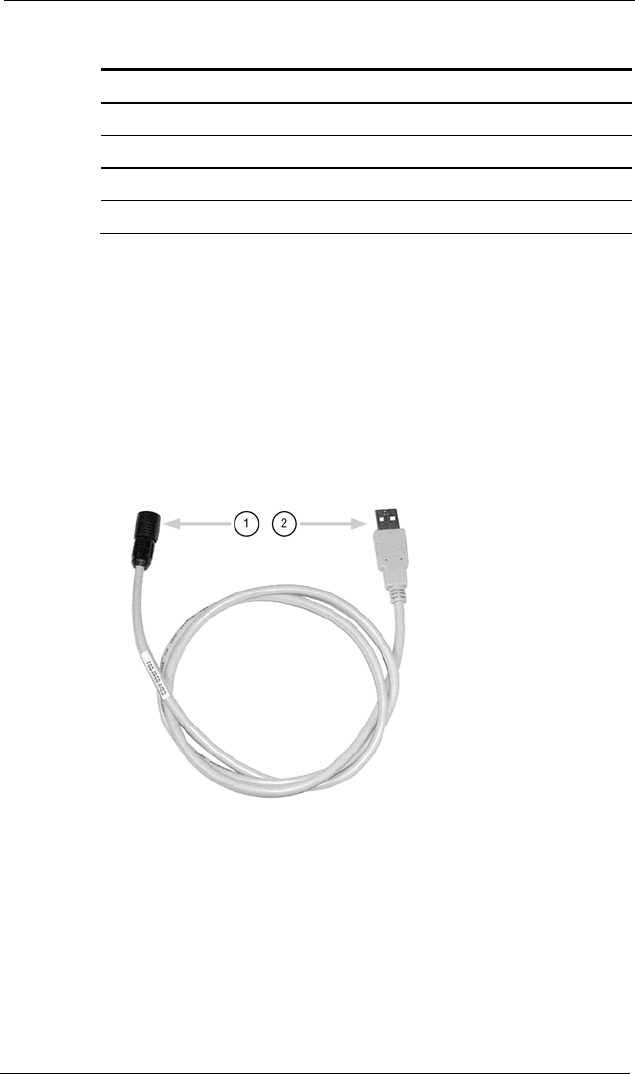
Maintaining Your 900MHz Belt Clip Radio
900 MHz Belt-Clip Radio User’s Guide 17
Proprietary and Confidential
Power level
remaining
PWR LED power indicator
90% or more Four green flashes
75% or more Three green flashes
50% or more Two green flashes
25% or more One green flash
25% or less Four red flashes
After it indicates the power level, the BCR runs through an LED
test cycle.
To charge the battery through the USB cable
1. Connect the Hirose connector (1) on one end of the USB cable
to the BCR’s communication port (see USB Communication
Port).
2. Connect the USB connector (2) on the opposite end to your PC's
USB port.
When the BCR is connected to a PC through its USB cable, but not
drawing power through its cradle (see To charge the battery through
the cradle), the USB cable provides the BCR with power from the PC
as well as USB communications.
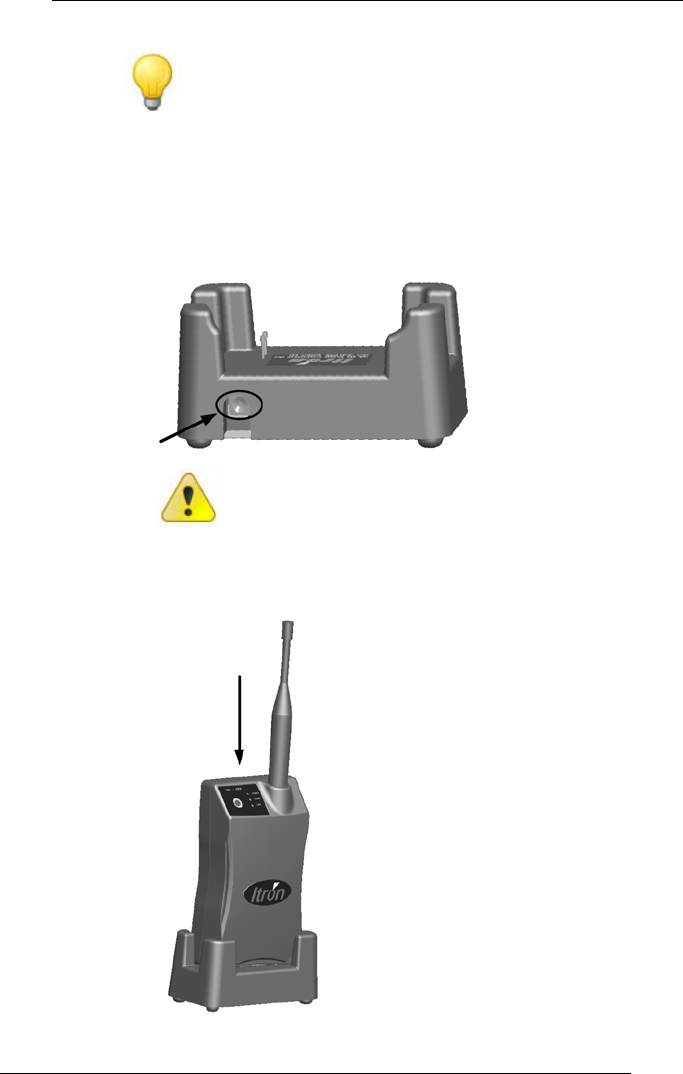
Maintaining Your 900MHz Belt Clip Radio
18 900 MHz Belt-Clip Radio User’s Guide
Proprietary and Confidential
Tip The charge time may be much longer through the
USB cable than through the AC adapter and cradle, as
the PC can supply only limited power.
Bluetooth communication is not possible when the
USB cable is connected.
To charge the battery through the cradle
1. Plug one end of the AC adapter to the corresponding socket in
the back of the the cradle.
Caution Use only an Itron-approved AC adapter with a
12-volt, 3.5 amp input power rating with this device.
2. Plug the other end into an AC electrical outlet.
3. Insert the BCR into the cradle.
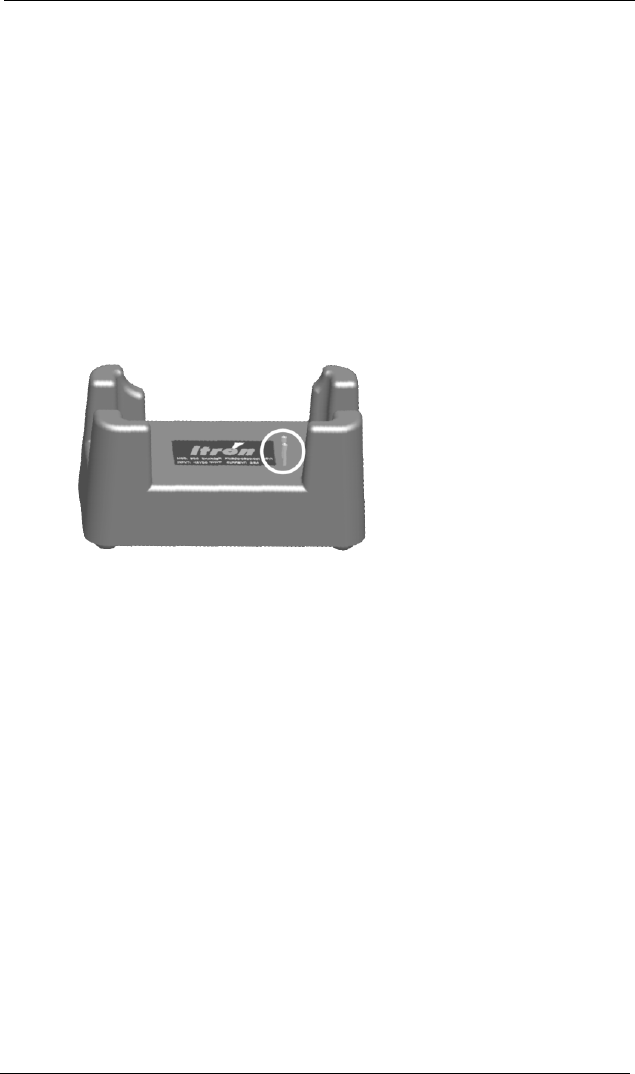
Maintaining Your 900MHz Belt Clip Radio
900 MHz Belt-Clip Radio User’s Guide 19
Proprietary and Confidential
When the BCR is plugged into the (powered) cradle, the cradle
provides it with power. While the radio is in the cradle, Bluetooth
communication is possible, as long as the USB cable is not connected
to the radio. If the USB cable is connected (see To charge the battery
through the USB cable), the radio still draws power from the cradle,
but communication can take place only through the USB cable, and
Bluetooth communication is disabled.
Replacing the Charging Cradle’s Contact Pins
If the contact pins on the charging cradle become bent or broken, you
can easily replace them. Use your fingers or a pair of needle-nosed
pliers to remove the damaged pins and insert new ones in the empty
holes.
Spare or replacement contact pins are available directly from Itron
customer service representatives (part number 320-0167-002). Use
only replacement pins provided by Itron with the 900MHz Belt Clip
Radio charging cradle.
Storing Your 900MHz Belt Clip Radio
Your 900MHz Belt Clip Radio can be safely stored for two weeks or
less with simple preparation. Follow the steps below to prepare your
BCR for short-term storage.
Remove the battery before storing the device for longer periods.
To store your BCR
1. Connect the BCR to external power and allow the battery pack
to fully charge.
• If the radio is on, the POWER LED flashes green twice
(quickly) every two seconds while charging. When it shines
steadily green, charging is complete.

Maintaining Your 900MHz Belt Clip Radio
20 900 MHz Belt-Clip Radio User’s Guide
Proprietary and Confidential
• If the radio is off, the POWER LED flashes alternately red
and green while charging. It stops flashing and the light goes
off when charging is complete.
See LED Status Indicators on page 10.
2. Remove external power, exit all applications, and turn off the
unit before placing it in storage.
Upon removal from storage, the battery pack requires additional
charging.
Note Remove the BCR’s battery before storing the
device for periods longer than two weeks.
Daily Operation
Itron recommends the following daily measures to help maximize the
service life of your 900MHz Belt Clip Radio and resolve any
problems you might experience.
• At the beginning of each day of operation, inspect the radio for
broken, loose, or missing parts and fasteners, taking corrective
action as required.
• Make sure the BCR is operated and stored within the
recommended temperature range.
– Operating temperature: -4° F to 140° F (-20° C to 60° C)
– Storage temperature: -40° F to 158° F (-40° C to 70° C)
Cold temperature extremes may result in reduced available
energy from the battery pack. This energy is recoverable as the
battery pack warms to 68° F (20° C).
Do not subject the radio to extreme temperatures, such as
leaving it in a vehicle in bright sunlight. Extended exposure to
warm temperature extremes can result in permanent reduction in
available energy from the battery pack.
Charging is disabled below 32° F (0° C) and above 113° F (45°
C) to protect the lithium-ion batteries.
• Conserve battery pack energy when possible to maximize
battery life during daily use.
Shallow or partial discharge and charge cycles are preferred,
rather than allowing the battery pack to drain completely before
recharging it.
Charging after a shallow or partial discharge does not degrade
battery pack life or performance.

Maintaining Your 900MHz Belt Clip Radio
900 MHz Belt-Clip Radio User’s Guide 21
Proprietary and Confidential
• Exit all external applications at the end of each work day.
This ensures that all applications that have initiated
communications with the BCR have terminated their Bluetooth
links.

Maintaining Your 900MHz Belt Clip Radio
22 900 MHz Belt-Clip Radio User’s Guide
Proprietary and Confidential

900 MHz Belt-Clip Radio User’s Guide 23
Proprietary and Confidential
Your 900MHz BCR is ergonomically designed for safe, comfortable
use. However, as with all equipment, you should follow good
working practices while using it.
Some people experience discomfort while using electronic
equipment. If ignored, this discomfort can lead to repetitive stress
injury (RSI), also known as cumulative trauma disorder or repetitive
motion injury.
Minimize the risk by following these guidelines:
• Maintain good posture while using the radio. Keep your fingers
and body relaxed whenever possible.
• Avoid keeping your muscles tense for long periods. Change
tasks often to avoid prolonged muscle strain. Support the radio
while using it.
• Take frequent short breaks. Use these breaks to exercise the
muscles in your hands, arms, shoulders, neck, and back.
AC Power Adapter
The 900MHz BCR’s AC power adapter (see Unpacking Your
900MHz Belt Clip Radio on page 3) is safe and simple to use.
Follow these instructions to help insure your safety and extend the
life of the adapter:
• Use the adapter indoors only.
• Avoid spilling liquid on the adapter.
Do not connect it if it is damp.
• Make sure ventilation around the adapter is not restricted while
it is in use.
• Use only the AC adapter supplied with your 900MHz BCR.
Do not substitute an alternative or unapproved adapter; this may
damage the BCR and void the warranty.
• Inspect the AC adapter before use.
Do not use it if there are any signs of damage or deterioration.
• Make sure all connectors are firmly connected.
• Avoid mechanical strain to cables and connectors.
C
HAPTER
6
Safety

Safety
24 900 MHz Belt-Clip Radio User’s Guide
Proprietary and Confidential
• Make sure the adapter’s green LED is lit while the adapter is in
use.
• In the event of overloading, the AC adapter is designed to be
fail-safe and may stop functioning.
• Do not try to use the AC adapter to power any other equipment.
• Avoid use in dusty, damp, or contaminated environments.
Warning The AC power adapter contains hazardous
voltage. It contains no user-serviceable parts. Do not
try to open or modify it.

900 MHz Belt-Clip Radio User’s Guide 25
Proprietary and Confidential
If you have a problem with your 900MHz Belt Clip Radio, review
the appropriate troubleshooting steps listed below. After that, if the
problem remains unresolved, contact an Itron customer service
representative (e-mail: support@itron.com; phone: 1 800 635 8725).
Problem
Possible Solutions
Battery does not
charge
• Verify the connection and power to
the charging cradle (if used).
• Check that the BCR is fully seated in
the cradle (if used). The BCR should
turn on when connected to external
power, and the POWER LED should
flash.
• Check the cradle’s contact pins for
damage, and make sure they touch the
contacts on the bottom of the BCR
when you place the device in the
cradle. Replace the pins if they are
damaged (see Replacing the Charging
Cradle’s Contact Pins on page 19).
• If charging through the USB cable, try
a different USB port on the PC. The
port may be bad or incapable of
providing sufficient current for
charging.
• Check the battery charge information
through the mobile data collection
application on the handheld or laptop
data collector connected to the BCR.
Make sure there are no errors or
anomalies.
C
HAPTER
7
Troubleshooting

Troubleshooting
26 900 MHz Belt-Clip Radio User’s Guide
Proprietary and Confidential
Battery power
drains quickly
• Make sure the battery indicates a full
charge following an overnight charge
(see Power Indicator LED).
• Typical useful life of the BCR battery
pack is between 300 and 500
charge/discharge cycles. Replace the
battery when its capacity drops to 70
percent of its original capacity.
• If the battery’s power does not last
following a full charge, return the
BCR to an approved Itron service
center to have its battery replaced.
USB connection
problems
• Visit the FTDI website and download
the latest drivers that support FT232R
devices.
• Install drivers
Bluetooth
connection
problems
• See your application’s user guide for
setup information.
Optimizing Bluetooth Performance
To optimize the performance of Bluetooth communication between
the 900MHz Belt Clip Radio and its host computer, keep the
following points in mind.
• Bluetooth communication works best when the communicating
devices have a line-of-sight orientation—that is, when you have
an unobstructed view from one device to the other. When
possible, remove or reduce obstacles between the 900MHz Belt
Clip Radio and its host computer during Bluetooth
communication.
• The BCR’s internal Bluetooth antenna emits its strongest signal
through the front of the device. Try to face the BCR toward the
computer during Bluetooth communication.
• The internal location of a computer’s Bluetooth device varies
between different computer models. Changing the host
computer’s orientation toward the BCR may improve Bluetooth
communication.

Troubleshooting
900 MHz Belt-Clip Radio User’s Guide 27
Proprietary and Confidential
• Keep metal objects away from the BCR and its antenna during
Bluetooth communication. They can impede the Bluetooth
signal and hurt performance.
• Because of the way the Bluetooth communication protocol
works, communicating devices must be closer to each other
when they first establish communication than they must be to
maintain the connection afterwards. If the connection fails
between the BCR and the computer, you may have to move
closer to reconnect.

Troubleshooting
28 900 MHz Belt-Clip Radio User’s Guide
Proprietary and Confidential

900 MHz Belt-Clip Radio User’s Guide 29
Proprietary and Confidential
Equipment Description
Model: 900MHz Belt Clip Radio
FCCID: EO9BCR900
IC ID: 864A-BCR900
900MHz Belt Clip Radio
Transmitter Information
Transmit frequency MAS: 952 MHz–957 MHz
Transmit frequency ISM: 908 MHz–923.8 MHz
MAS transmitter conducted power: +22 dBm
ISM transmitter conducted power: +10.5 dBm
Transmitter gain: Firmware controlled; +30dB maximum
Antenna type: omnidirectional
Antenna transmitter gain: 2.0dBi
Transmission duration: Check ERT function: Keyed transmit lasting between 1.25 and 7 seconds initiated on demand from
operator. Duration is dependent on the success of the communications event with the endpoint.
Receiver Information
Frequency ISM: 908–923.8 MHz
Receiver gain: Firmware controlled: 26dB minimum
Antenna type: Omnidirectional
Antenna receive sensitivity: -112.45 dBm
Bluetooth
Manufacturer: BlueGiga
Model: WT11-A
FCC ID: QOQWT11
IC ID: 5123A-WT11-E
Transmitter Information
Transmitter class: Class 2
Transmit frequency: 2400 MHz–2483.5 MHz, spread spectrum
Transmitter power (max): +14 dBm to +18 dBm
Transmitter power (min): –11 dBm to –9 dBm
Antenna type: integral
Transmission type: data
Modulation type: GFSK, DQPSK
Signal information: Bluetooth
Receiver Information
Frequency: 2400 MHz–2483.5 MHz
Antenna type: integral, chip
Antenna receive range: –82 dBm to –20 dBm
A
PPENDIX
A
900MHz Belt Clip Radio Capabilities and Limitations

900MHz Belt Clip Radio Capabilities and Limitations
30 900 MHz Belt-Clip Radio User’s Guide
Proprietary and Confidential
Specific Absorption Rate Data
This model of the 900BCR meets the government’s requirements for exposure to radio waves.
Your 900BCR has a radio transmitter and receiver. It is designed and manufactured not to exceed limits for exposure to
radio frequency (RF) energy set by the Federal Communications Commission (FCC) of the U.S. government and by the
Canadian regulatory authorities. These limits are part of comprehensive guidelines and establish permitted levels of RF
energy for the general population. The guidelines are based on standards that were developed by independent scientific
organizations through periodic and thorough evaluation of scientific studies. The standards include a substantial safety
margin designed to assure the safety of all persons, regardless of age or health.
The exposure standard for wireless mobile and/or portable devices employs a unit of measurement known as the specific
absorption rate, or SAR. The SAR limit set by the FCC and by the Canadian regulatory authorities is 1.6 W/kg1. Tests for
SAR are conducted using standard operating positions accepted by the FCC and by Industry Canada with the 900BCR
transmitting at its highest certified power level in all test frequency bands. Although the SAR is determined at the highest
certified power level, the actual SAR level of the 900BCR while operating can be well below the maximum level. This is
because the 900BCR is designed to operate at multiple power levels, depending on the needs of the customer.
Before a BCR model is available for sale to the public in the U.S. and Canada, it must be tested and certified to the FCC
and Industry Canada that it does not exceed the limit established by each government for safe exposure. The tests are
performed in positions and locations (for example, worn on the body) and reported to the FCC and made available for
review by Industry Canada. The highest SAR value for this model BCR when tested for use when worn on the body as
described in the user’s guide is 0.314 W/kg. While there may be differences between the SAR levels of various BCR models
and at various positions, they all meet the government requirements for safe exposure. Please note that improvements to
this product model could cause differences in the SAR value for later products; and in all cases, products are designed to be
within the guidelines.
----------------------
1 In the United States and Canada, the SAR limit for wireless mobile and/or portable devices used by the public is 1.6 W per
kilogram averaged over 1 g of tissue. The standard incorporates a substantial margin of safety to get additional protection
for the public and to account for any variations in measurements.
Warning Use this device only in a manner consistent with
this user’s guide.